1. Reasons for Hosting the Nursing Experience Class under the One-Day University Experience Program for Elementary School Children
To nurture children's "zest for living," we believe that it is necessary to design a learning environment where children can directly experience things and understand the meaning and significance of learning. At the same time, it is also important to establish a community framework that supports children's experiential learning. According to the "Survey on Experiential Learning Activities in Young Age" conducted by the National Institution For Youth Education in 2010, it is revealed that people who have enriched childhood experiences are likely to be more motivated to attempt something or to find something which makes their lives worthwhile.
Since 2016, we have been hosting the "Bunkyo Kids' College" program at Hokkaido Bunkyo University. This program aims to provide opportunities for local elementary school children and parents to experience half-day nurse training classes using the facilities of the university nursing department. Children and parents can experience basic nursing training in the nursing practice room using actual educational materials used by the students of the nursing department. This experience-based learning allows both children and parents to think about a nursing career and what they could learn at the university. We host the program during school vacations in summer and winter, so as to let children reflect on their experience in their project assigned as vacation homework. Over the past three years, we have hosted six classes in total.
The reason why we planned this experience-based learning is that we want children in our community to recognize the existence of the local university and think about a nursing career through their experience as a nurse/patient using a medical treatment model. We also hope that these children can gain valuable experiences in their early childhood through this career education, which will give them more learning and career options in the future. Another reason is that, as faculty members of the university providing nursing training courses, we feel a sense of crisis over the attitudes of university students towards learning. Nowadays, we often see students who are taking nursing courses or other undergraduate courses without a clear vision of future career or learning objectives. These students say things like, "I couldn't decide by myself what I want to be in the future and chose a nursing university recommended by my parents," "I'm not sure whether I really want to become a nurse, but a nursing qualification would be useful to make a living in the future," or "I just want to get a university degree." There are students who entered a nursing university without a clear vision or purpose and dropped out of specialized education or hospital training. Nowadays, this phenomenon is observed as a major concern in every nursing university in Japan. We believe that this learning experience with nursing experts and actual medical resources at university can be beneficial for elementary school children in terms of providing not only a fun event but also an opportunity to understand the nursing profession and think about it as one of their future career options. For these reasons, some faculty members (including myself) in charge of nursing training or child development studies voluntarily collaborated and started the "Bunkyo Kids' College" program as one of the community contribution activities to enhance the enriched development of local children.
Actually, this kind of nursing experience class for young children is quite often held throughout Japan. Through the "Bunkyo Kids' College," we aim to provide opportunities for children and parents to gain experience as a nurse and discuss together the importance of life and the feelings of patients. To realize our objective, we refined the nursing experience program by collecting and summarizing feedback and opinions from elementary school children and parents who participated in the program. Furthermore, we evaluated this nursing experience program based on the results of the classes hosted over the past three years (Taga, Hattori, Fukushi, Shikanai, Kohei and Kasami; 2019). In the next section, I will explain the results of our evaluation.
2. Structure and Progress of "Bunkyo Kids' College"
The program consisted of half-day classes conducted in the morning (9:30-12:20) and in the afternoon (13:30-16:20), respectively. The participants were elementary school children of all grades. They participated in the program with their parents (or grandparents/other adults, as well as their siblings at preschool/school-age, if any). We also provided a babysitting service for these parents to let them enjoy the program without concern.
"Bunkyo Kids' College" - One-day university experience program
- Distribute a nurse uniform (in several child-sizes and colors; children can choose the size and color. Leased for the day) to the participant children, along with educational materials and a one-day student pass (a name card)
- Short lecture: "What kind of place is the university?"
- University expedition: "Let's explore the university!"
- Experience of nurse training
- A certificate of completion is given to each participant child
Children and Parents in the Class
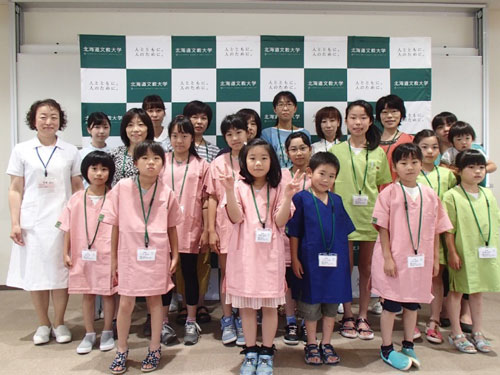
|
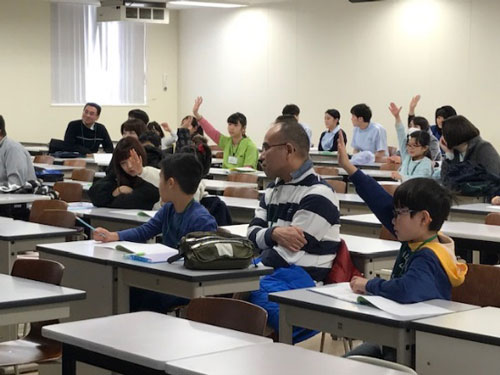
| |
|
(1) Children in a nurse uniform |
(2) Short lecture: Children learned differences between elementary schools and universities using a quiz-format textbook |
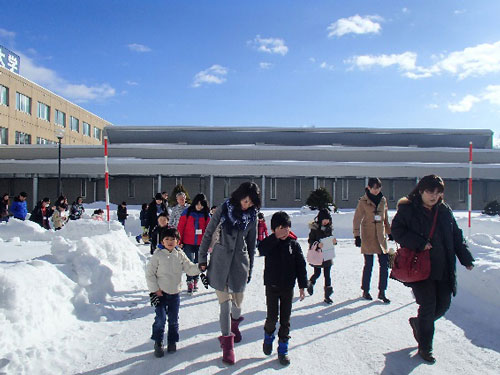 |
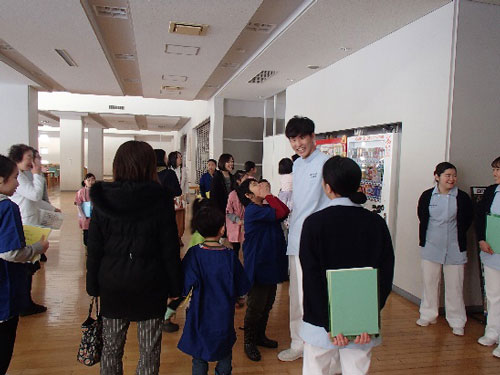
| |
(3) University expedition: University students took children on a campus expedition tour, exploring university canteens, libraries, laboratories, conference rooms, practice rooms, etc. - most of which do not exist in elementary schools. | ||
The contents of the classes were divided into three courses: (1) "Experience as a nurse" to learn how to take care of patients, (2) "Experience as a patient" to understand how pregnant women, aged people, and care receivers would feel, and (3) a combination of (1) and (2).
At the beginning of the class children received a quick explanation using lecture sheets describing "How to become a nurse," "Important things for a nurse," and "Importance of our life."
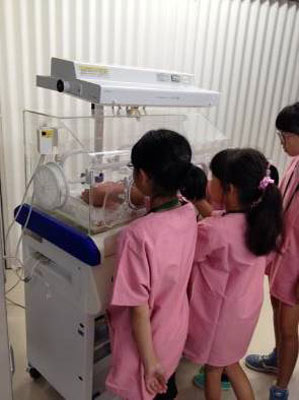 |
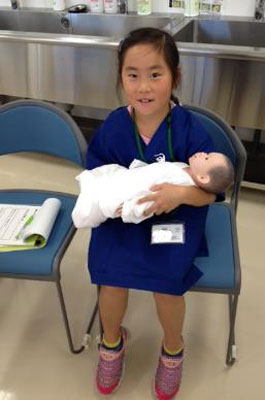 |
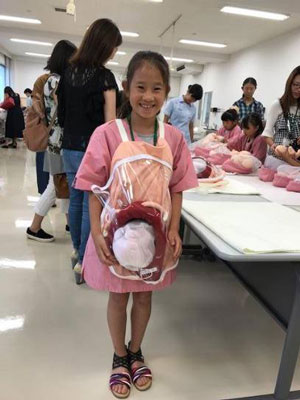 | ||
| Children putting their hands in an incubator, feeling the interior air temperature and understanding the actual size of a premature infant. | A child holding a newborn-baby doll weighing three kilograms. At this stage, many mothers started talking about the babyhood of their child. | Maternity simulation: A child wearing a child-size maternity simulation jacket, feeling the weight of a fetus in the womb. |
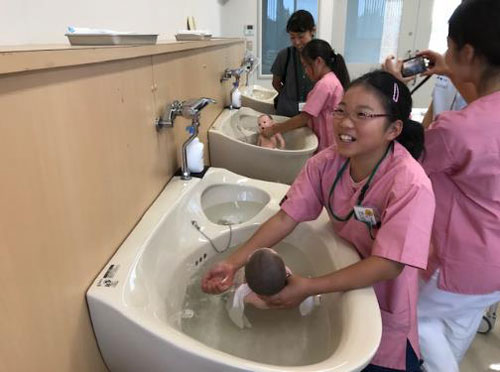 |
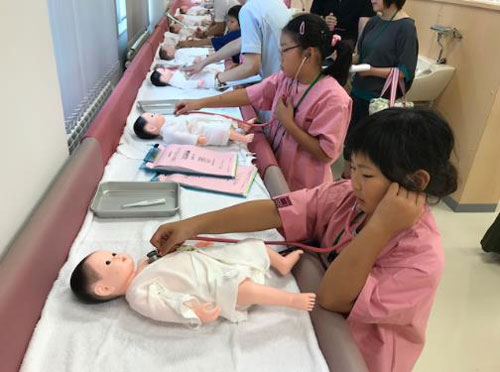 |
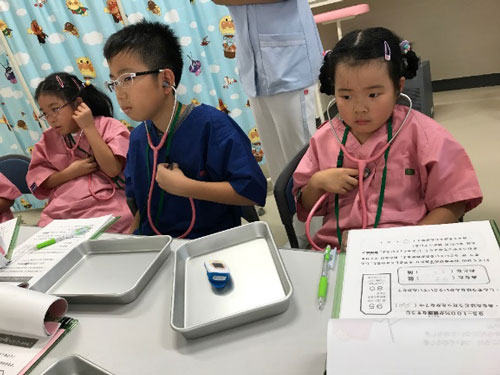 | ||
| Bathing a newborn baby: Parents or university students supported this activity. This can be done even by lower-grade elementary school children. No need to be concerned about precise skills since the focus of this lesson is to experience taking care of a baby. | Children using a stethoscope to check a newborn-baby doll's breathing sounds and heartbeat. They were surprised that a baby had a high heart rate per minute. | Children using a stethoscope to check their heartbeats. They recognized the difference between the heart rates of babies and their own heart rates, learning that heart rates will decrease as they grow. |
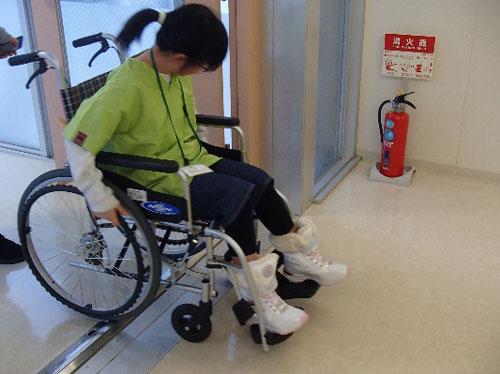 |
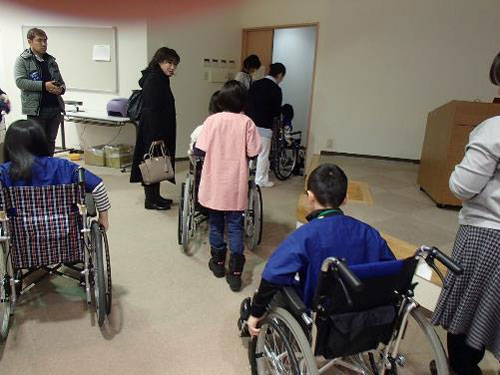 | |
| Wheelchair mobility experience: Children using a wheelchair. In this lesson, children recognized the difficulty of accessing different floor levels, as well as the difference between the speed of a wheelchair when being pushed by someone and operating it themselves. When pushing a wheelchair, they felt it was very difficult to navigate obstacles and go through a narrow path. | ||
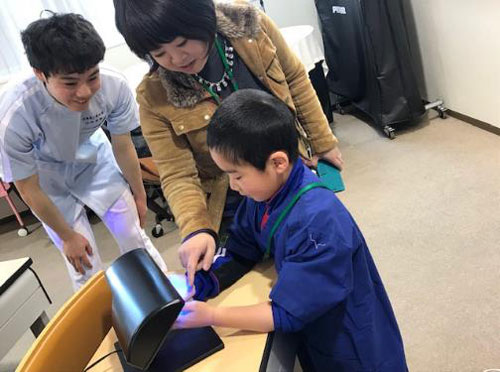 |
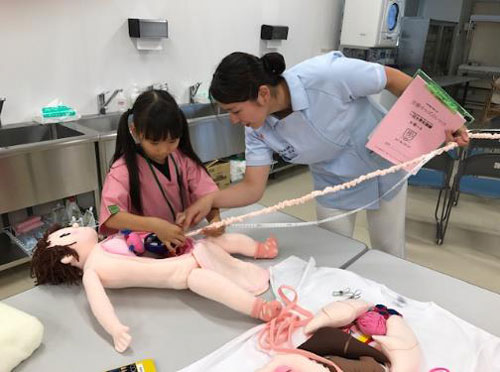 |
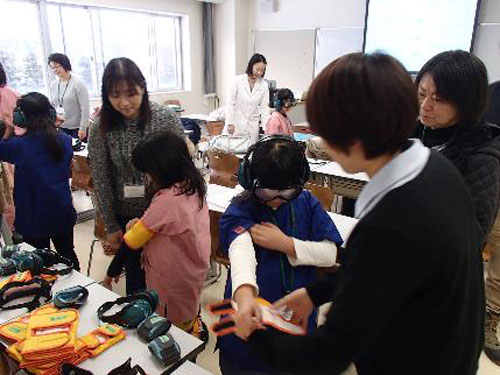 | ||
| A child using a hand washing checker that visualizes any wash residue. In this lesson, children learned the importance of careful hand washing to avoid disease-infections. | A child using an internal organ model to measure the length of small intestine and place each piece of the internal organs in the correct position. In this way, children learned the structure of internal organs and the functions of the digestive tract. | Children using the aged simulation kit, experiencing the inconveniences felt by aged people, such as visual acuity deterioration due to aging or cataracts, hearing difficulties, and restricted joint mobility. In this way, they learned how the elderly experience physical changes as they age. |
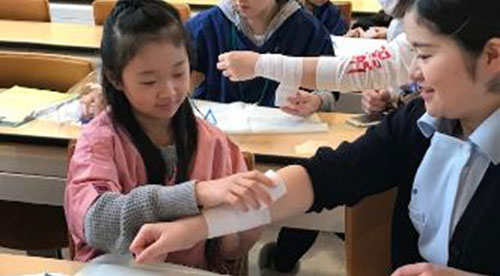 |
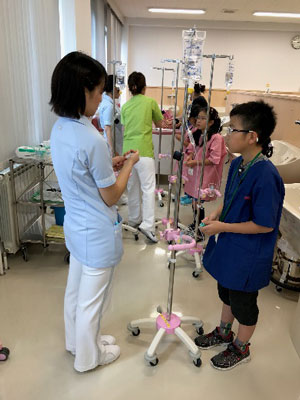 | |
| Children using the antiseptic solution and applying a bandage. It was surprisingly difficult for them to apply a bandage, ensuring the correct tightness and direction. | A child watching the adjustment of intravenous infusion rates. Those children who had been administered intravenous drips in the past were very interested in the relationship between infusion rates and the amount of intravenous dose. |
3. Purpose of Our Study
The purpose of our study is to identify what elementary school children experienced and learned through the "Bunkyo Kids' College" program, which we conducted for three years from 2016 until 2018. We also wished to confirm the degree of parents' satisfaction after the program. Therefore, we conducted a survey to evaluate this nursing experience class targeting elementary school children.
4. Survey Method
1) Participants
The survey targeted 156 children in all grades of elementary school and 134 parents, who participated in the "Bunkyo Kids' College," a one-day university experience program, during the past three years from 2016 until 2018. We gave the participant children and parents a questionnaire form to conduct an anonymous survey and collected the form after completion of the program.
2) Survey items
The question items for children include (1) their grade (age), (2) feedback on their participation in the one-day university experience program, (3) feedback on their experience of nursing training, (4) the most important thing they learned, and (5) comments and opinions (Items (4) and (5) are open-ended questions). For their parents, the question items include (1) reasons for participation, (2) the degree of satisfaction with the program, and (3) comments and opinions. We also classified the categories of nursing experience under the program and summarized the class contents and educational materials according to each category.
3) Analysis methodology
We have conducted simple tabulation of responses to the questionnaire collected over the past three years. For the answers to open-ended questions, we conducted a content analysis. For children's answers regarding "Feedback on the participation," we collected by theme (i.e., aged simulation, wheelchair mobility experience, taking care of newborns: each theme was conducted twice over the past three years). We extracted and integrated free description parts and conducted analysis on frequent words using Word Cloud. This survey was granted approval from the university's ethical committee.
5. Results
Table 1: Breakdown of the Participants
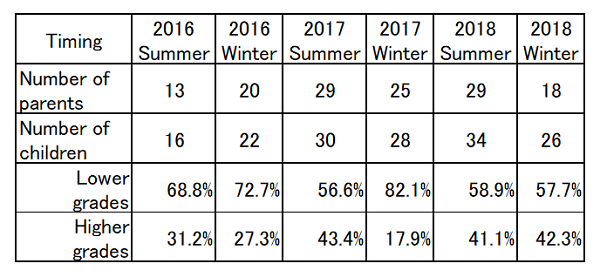
Table 1 shows that the majority of the participants in each class are children in lower grades of elementary school.
After analyzing the free descriptions of the participant children regarding the three themes of aged simulation, wheelchair mobility experience, and taking care of newborns, we found out that "wheelchair mobility experience" left the strongest impression on them. Other extracted comments include their understanding of inconveniences and physical characteristics which aged people feel, as well as emotional expressions such as "amazing," "heavy," "scary (frightening)" and "enjoyable." Apparently, these experiential activities helped children understand the feelings of care receivers, which they could not experience in their ordinary daily life.
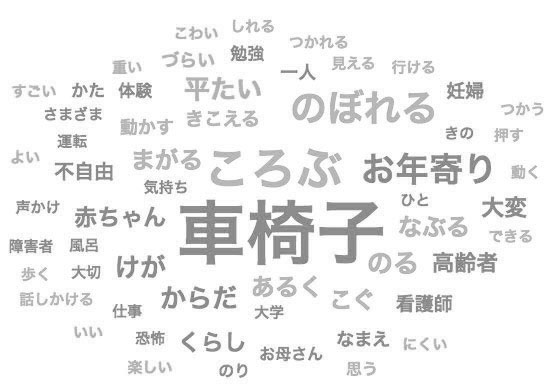 Figure 1: Word Cloud of Frequent Words (extracted from children's feedback on aged simulation, wheelchair mobility experience, and taking care of newborns)
Figure 1: Word Cloud of Frequent Words (extracted from children's feedback on aged simulation, wheelchair mobility experience, and taking care of newborns)Apart from the free descriptions, the most popular comments include (1) "I want become a nurse," (2) "I enjoyed nursing training," (3) "I want to encourage and help people with disabilities (sick and injured people)," (4) "The use of hospital equipment," (5) "I want to try the university cafeteria" and (6) "I want to touch a real baby."
There are also negative comments in the free description column such as "I don't want to be an aged person" and "I don't want be a nurse because of the hard work and heavy responsibility" (both are comments from the third graders). It is clear that not all children have developed admiration for and interest in the nursing profession through their experience here. Some children see the reality of professional work.
Table 2: Class categories, children's positive impression/learning motivation, and parents' satisfaction
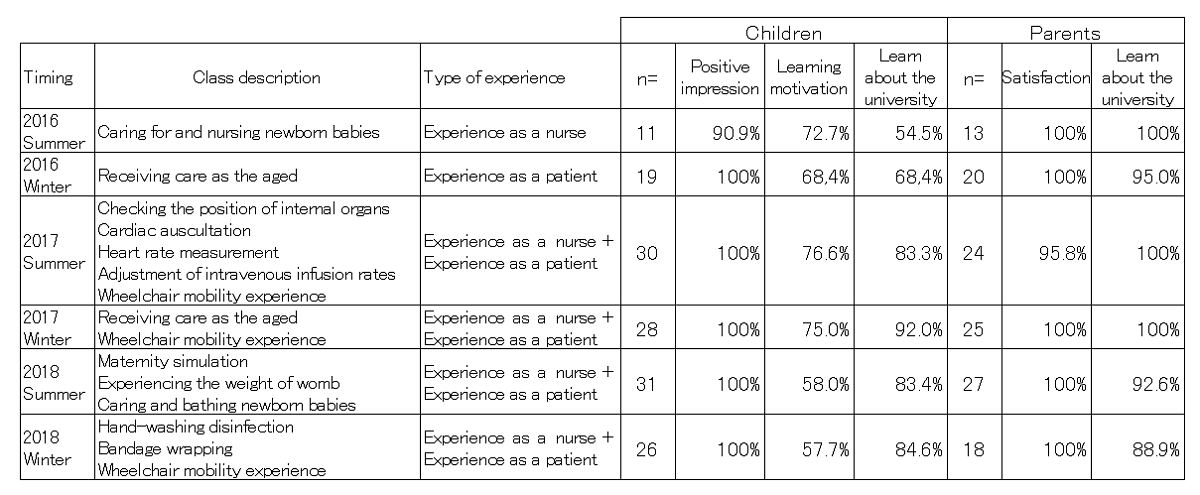
We classified experience activities in the nursing experience class into two categories: "Experience as a nurse," in which children receive training for nursing skills and tasks, and "Experience as a patient," in which children experience the actual feelings of patients, aged people, pregnant women, and babies. We conducted six classes in total, and of them, four classes were a combination of "Experience as a nurse" and "Experience as a patient." We found more feedback accounts and longer descriptions in these combined classes. In addition, parents were more satisfied with experiential activities using real nursing equipment such as applying a bandage, washing hands, disinfection, and the adjustment of intravenous infusion rates.
Children in higher grades showed higher satisfaction with precise nursing skills, while some children in lower grades commented they wanted to try more difficult skills such as "bathing a newborn baby." The most popular item of nursing equipment in the six classes was a wheelchair. Both children and parents in each class expressed more comments on what they had recognized and learned after the wheelchair mobility experience (using a wheelchair by themselves as well as pushing their parent in a wheelchair. These comments include "I recognized the difficulty of pushing it over steps or gaps." and "It is surprisingly hard to push a wheelchair properly."
6. Discussion
Evaluation on the nursing experience class for elementary school children
The nursing experience class, which we had conducted over the past three years under the one-day university experience program, left positive impressions on the participant children. The degree of parental satisfaction was also high (almost 100%). Considering these results, we can conclude that the structure and experiential activities of the program are sufficient. The program successfully offered an authentic "experience as a nurse/patient" for elementary school children by using actual educational nursing materials at the nursing university. After conducting a comprehensive analysis based on what the participant children had learned, we believe that this nursing experience class can contribute to the development of children's capabilities and abilities gained through various experiences (the ability to experience and learn things).
The National Institution For Youth Education stated that children's "ability to experience and learn things" has seven elements (i.e., self-esteem, symbiosis, motivation/curiosity, normative consciousness, interpersonal skills, professional awareness, and cultural behavior/ knowledge). The nursing experience class under the "Bunkyo Kids' College" program provides experience of four elements, that is, self-esteem, symbiosis, motivation/curiosity and professional awareness. Our survey results suggest that the nursing experience class for local children using university intellectual resources will contribute to the enriched development of children who are living in an age of declining birthrates.
References
-
A Report of "Survey on Experiential Learning Activities in Young Age" conducted by the National Institution For Youth Education
http://www.niye.go.jp/kenkyu_houkoku/contents/detail/i/62/ (in Japanese) - "3. Characteristics and focus issues at each stage of children's development" by the Ministry of Education, Culture, Sports, Science and Technology
http://www.mext.go.jp/b_menu/shingi/chousa/shotou/053/shiryo/attach/1282789.htm (in Japanese) - Azusa Shikanai, et. al., "Effects of a learning experience (nurse experience) program targeting local elementary school children and their parents at university," p42, the 15th Conference Minutes of the Japanese Society of Child Science
- "1.1: Educational significance of experiential activities" by the Ministry of Education, Culture, Sports, Science and Technology
http://www.mext.go.jp/a_menu/shotou/seitoshidou/04121502/055/003.htm (in Japanese)
* This document was created by revising the oral presentation (presented by Masae Taga, Yuko Hattori, Haruka Fukushi, Azusa, Shikanai, Yukari Kohei, Yasuhiro Kasami in 2019) at the Kansei Forum Sapporo 2019.



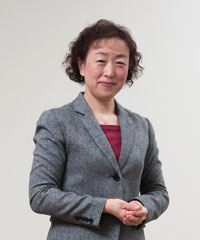 Masae Taga
Masae Taga










